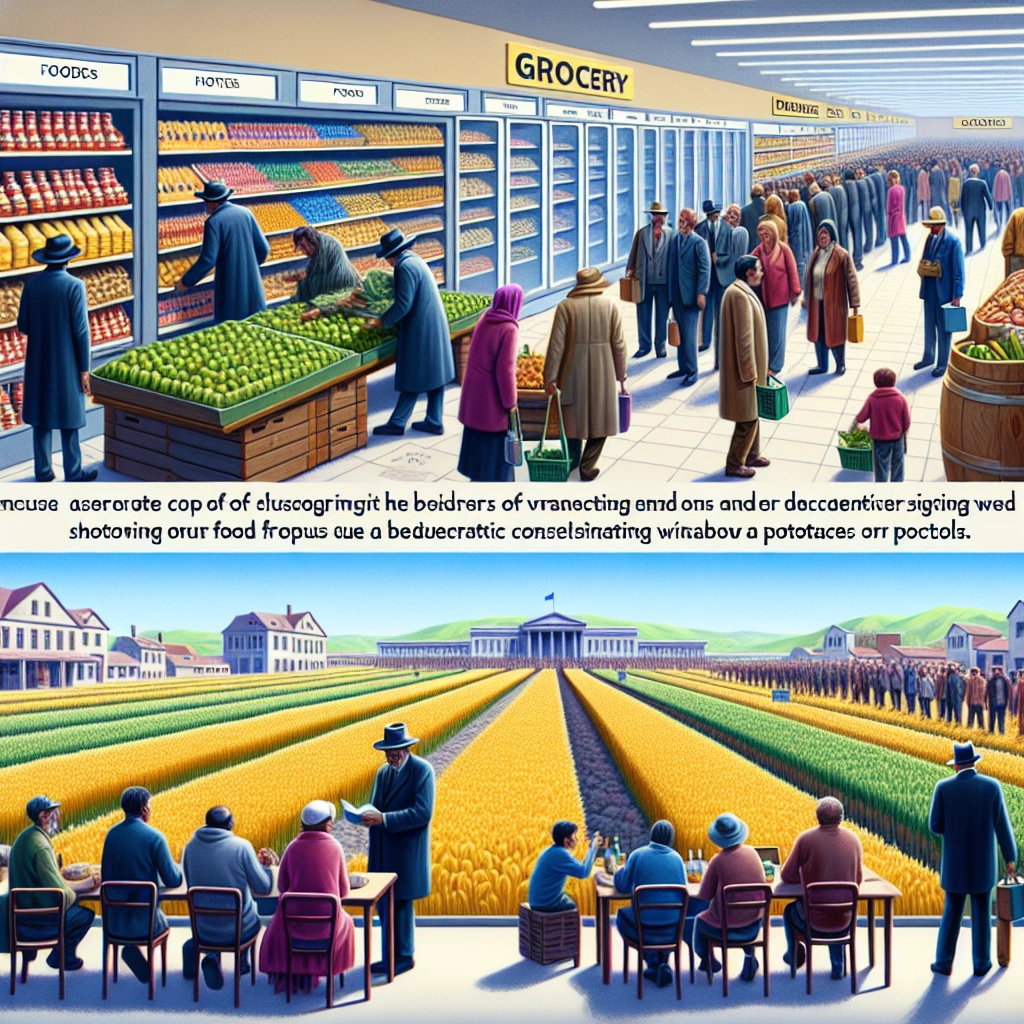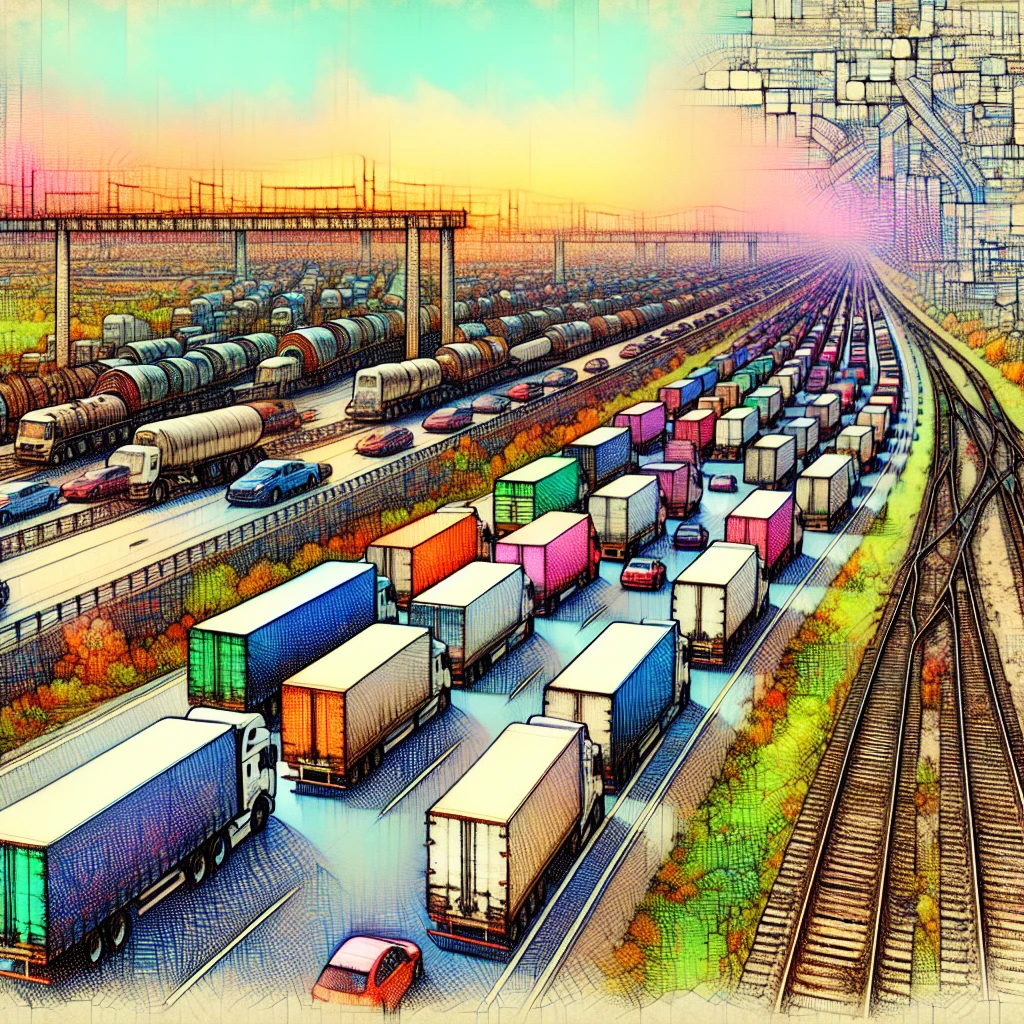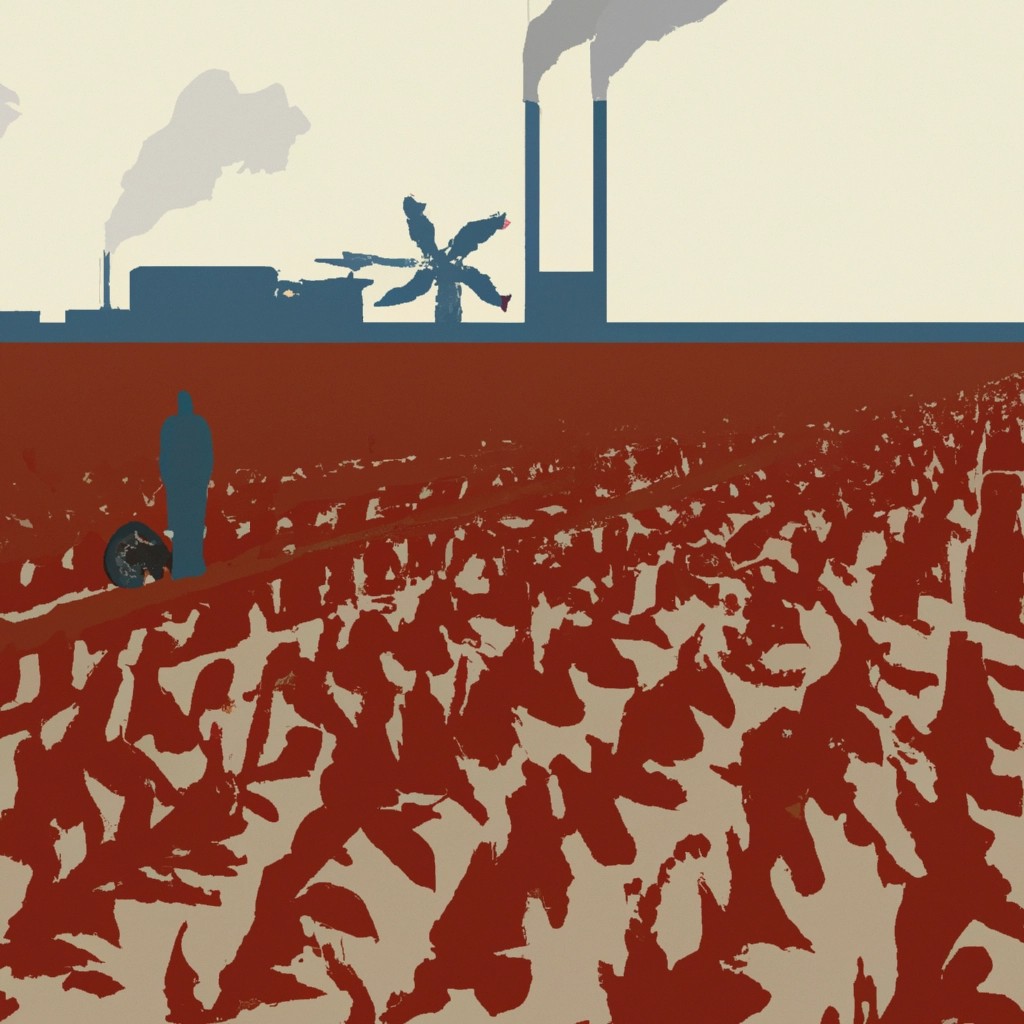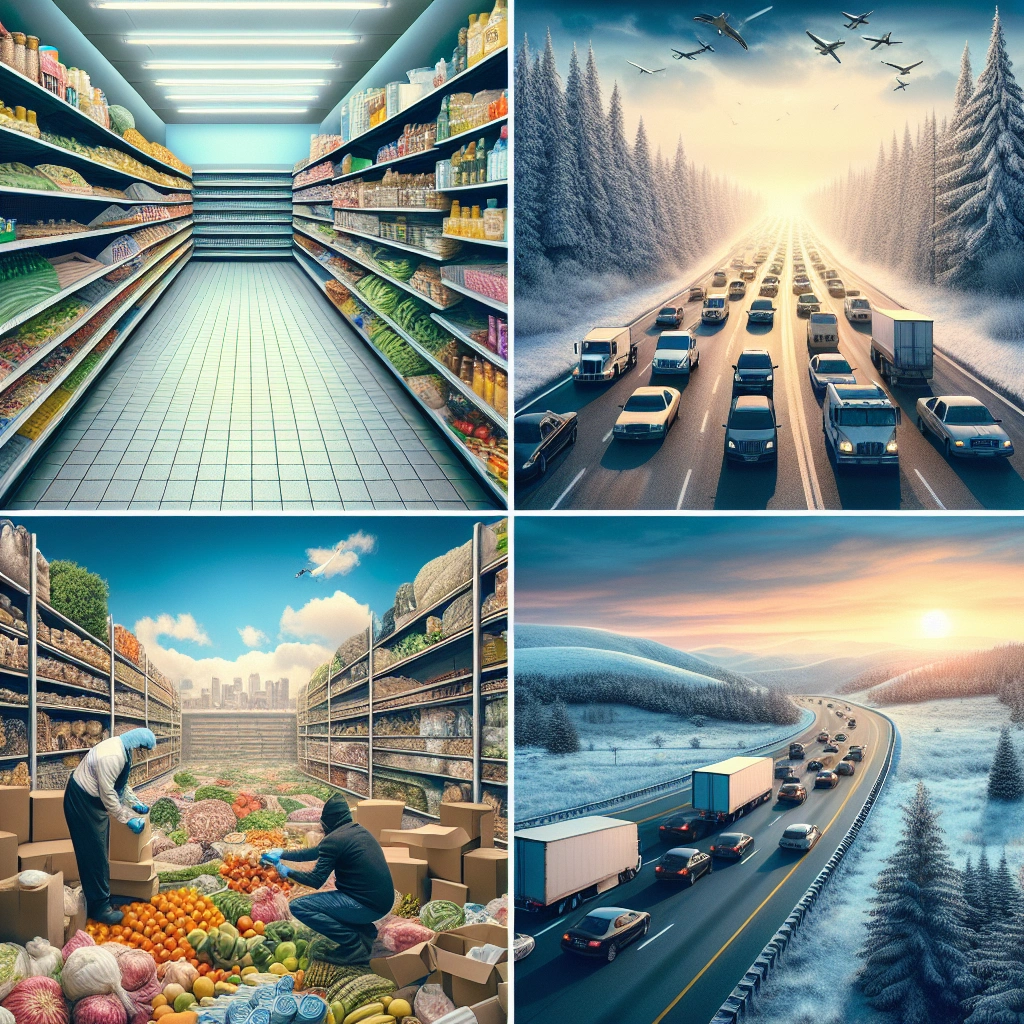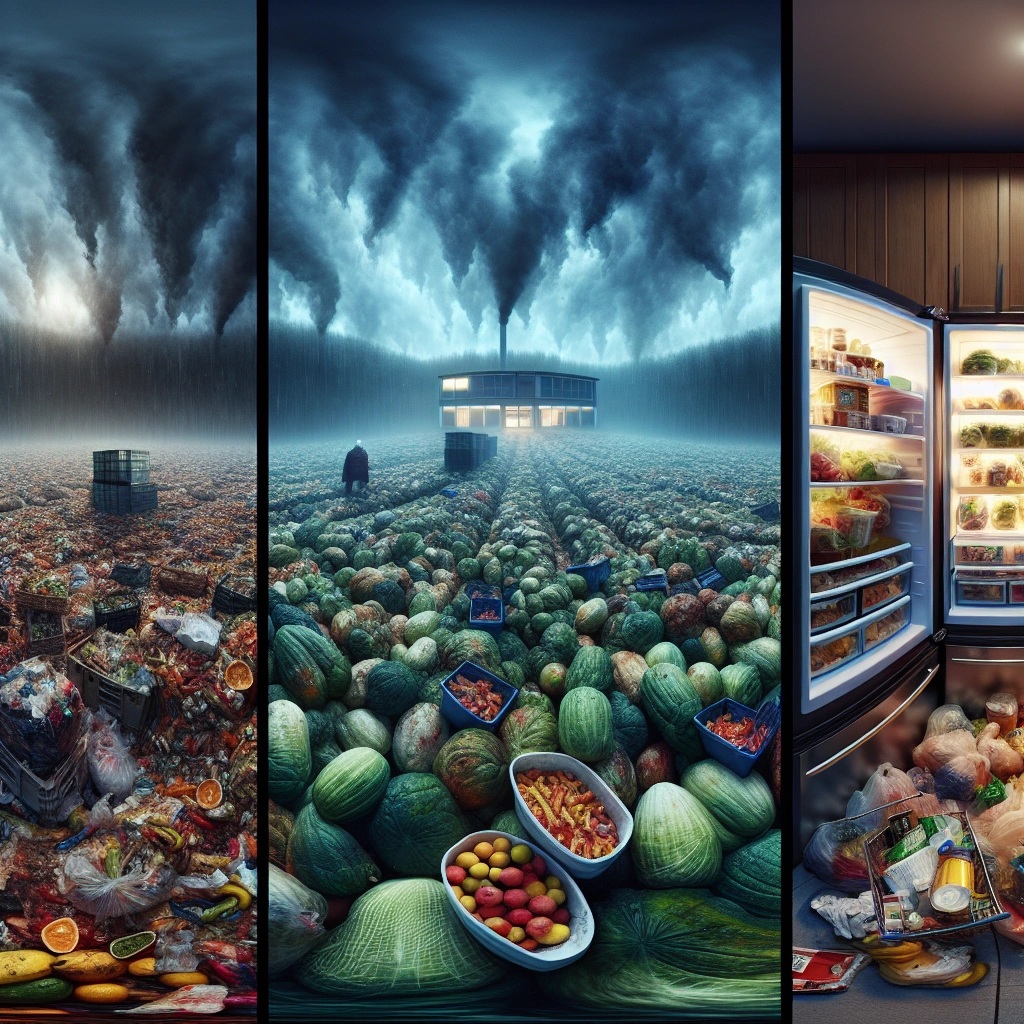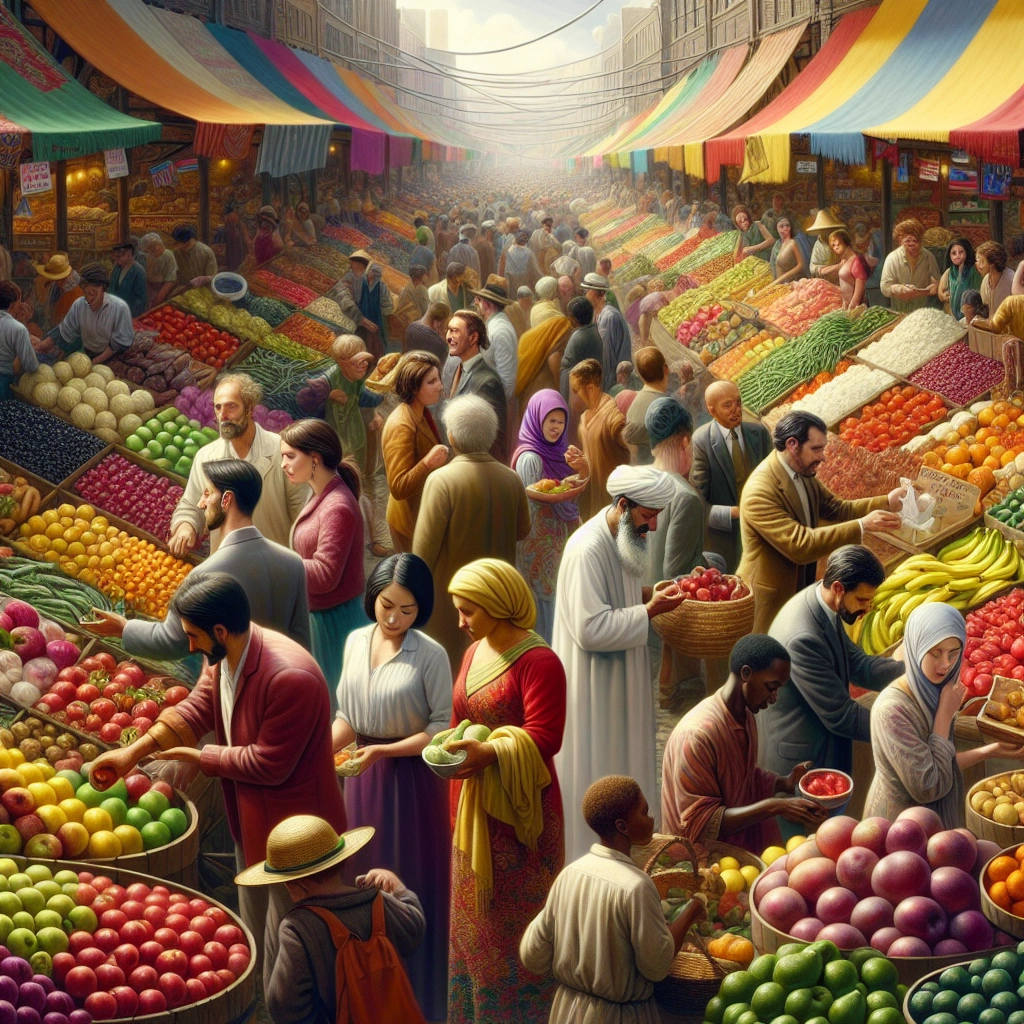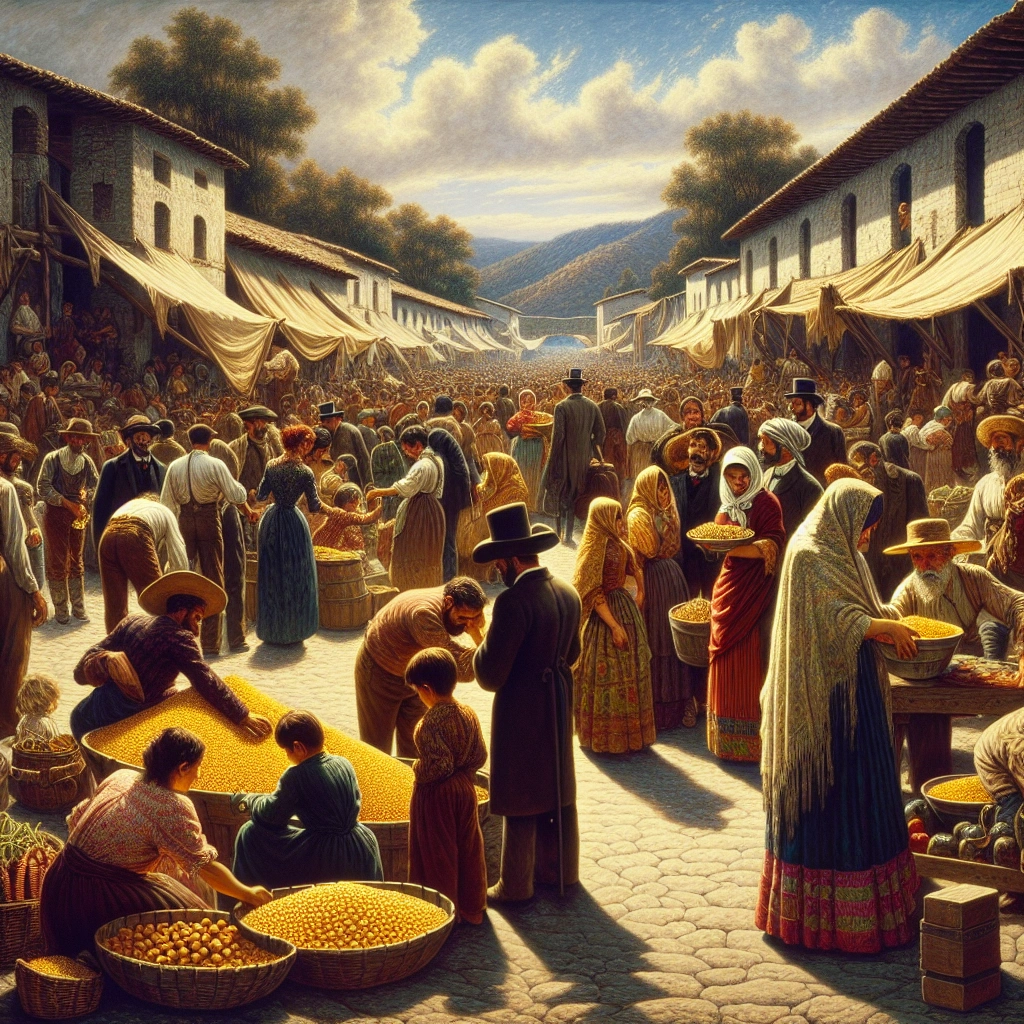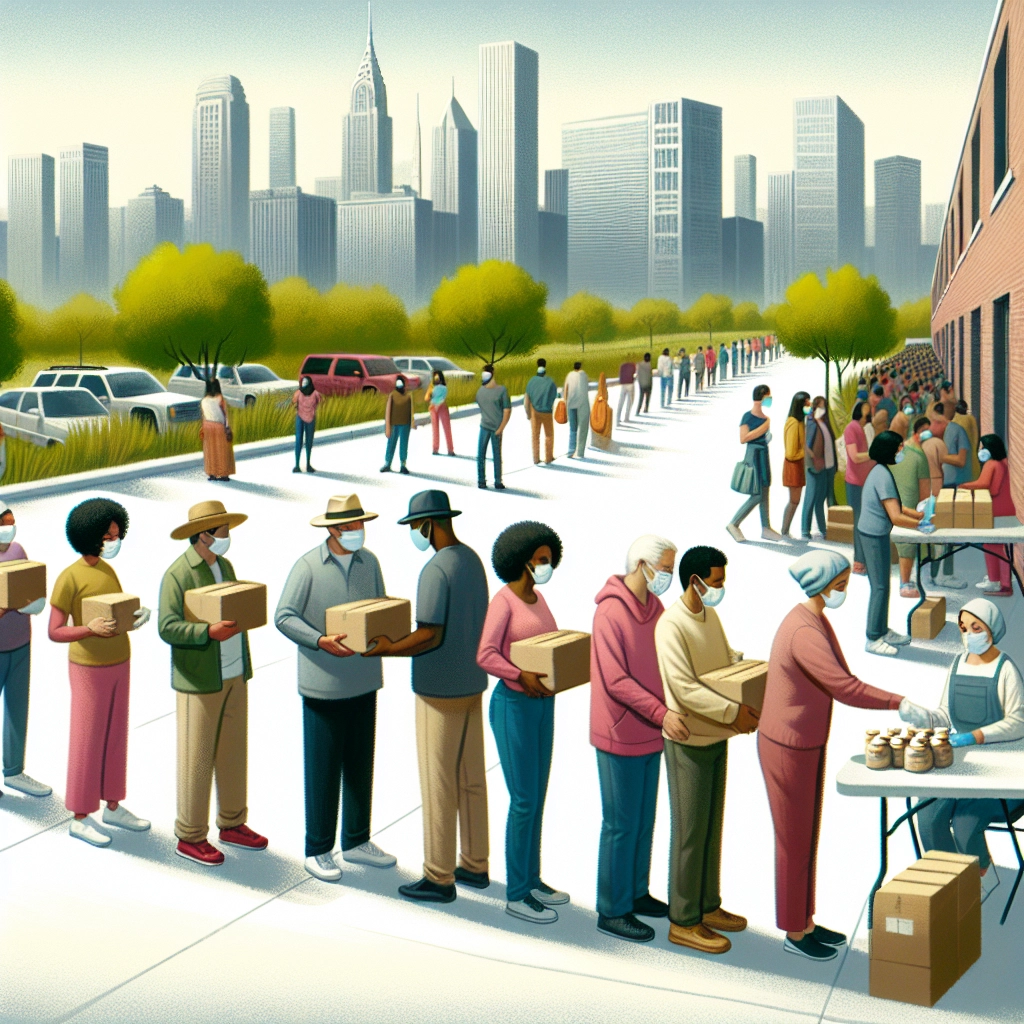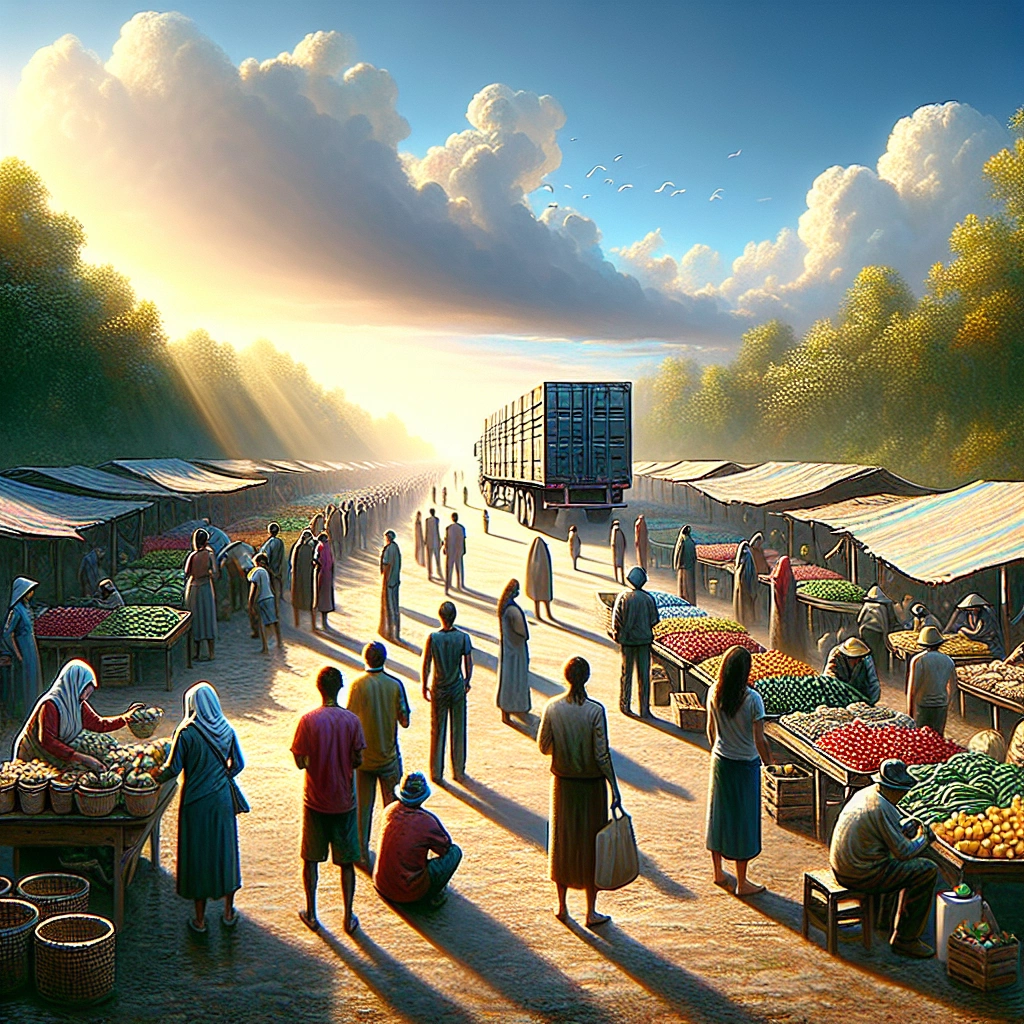

Food shortages in Europe and America have been exacerbated by factors such as increasing frequency and severity of climate shocks, supply chain disruptions due to the COVID-19 pandemic, and rising inflation. Conflict in certain regions, like the war in Ukraine, has also contributed to food insecurity in Europe and America.
Additionally, the global food crisis has been driven by greater poverty, high commodity prices, and disruptions in the global food supply chain.
Check out this Youtube video: “What’s behind the vegetable shortages in the UK | DW News” and discover the factors contributing to food shortages in Europe and America.
Economic Factors
Impact of economic downturns on food supply and demand
The impact of economic downturns on food supply and demand can be severe. During times of economic recession, the purchasing power of consumers diminishes, leading to a decrease in the demand for food products.
This, in turn, affects farmers and food producers who may experience reduced incomes due to lower demand, subsequently impacting their ability to invest in production. Additionally, economic downturns can lead to operational challenges for food supply chains, causing disruptions in the timely delivery of food products to consumers.
The instability created by economic downturns can exacerbate food shortages, especially for vulnerable populations.
Income inequality and its effect on access to food
Income inequality significantly affects access to food, with marginalized communities often facing the brunt of food shortages. As wealth gaps widen, lower-income individuals are compelled to allocate a higher proportion of their earnings towards food expenses, limiting their ability to afford an adequate and nutritious diet.
This, in turn, leads to higher instances of food insecurity and malnutrition among economically disenfranchised populations. Moreover, income inequality can perpetuate systemic barriers that obstruct access to quality, affordable food options, creating a cyclical pattern of food scarcity and financial hardship for marginalized communities.
Global trade and its influence on food shortages
Global trade plays a crucial role in determining the availability and distribution of food products worldwide. However, disruptions in global trade can significantly impact food shortages.
Dependence on international food imports makes regions vulnerable to supply chain disruptions, geopolitical conflicts, and trade restrictions, resulting in compromised access to essential food supplies. Furthermore, trade policies, tariffs, and export bans can further exacerbate food shortages by limiting the flow of food products across borders, thereby affecting the availability of diverse food options and essential nutrients for local populations.
Additionally, reliance on global trade can render countries susceptible to price volatility and market fluctuations, intensifying food scarcity challenges.
| Factors | Impact on Food Shortages |
|---|---|
| Economic Downturns | Decreased consumer purchasing power leading to reduced demand for food products, operational challenges for food supply chains, and exacerbated food shortages especially for vulnerable populations. |
| Income Inequality | Higher instances of food insecurity and malnutrition among economically disenfranchised populations, perpetuating systemic barriers that obstruct access to quality, affordable food options. |
| Global Trade | Dependence on international food imports making regions vulnerable to supply chain disruptions, trade policies, tariffs, and export bans exacerbating food shortages, susceptibility to price volatility and market fluctuations. |
The interplay of economic downturns, income inequality, and global trade intricately contributes to the dynamic landscape of food shortages in Europe and America, necessitating holistic solutions to address these multifaceted challenges.
Climate Change and Weather Patterns
How climate change affects crop production
The relentless march of climate change deeply impacts crop production by altering temperature, precipitation, and carbon dioxide levels. As temperatures rise, evaporation accelerates, leading to more frequent and prolonged droughts that impede crop growth.
Additionally, the shifting precipitation patterns cause unpredictable water availability, disrupting agricultural output. Warmer temperatures also facilitate the proliferation of pests and diseases, posing further threats to crops.
The associated increase in carbon dioxide levels can both positively and negatively affect crop yields, depending on the adaptability of the specific plant species.
Impact of Climate Change on Crop Production
| Climate Factor | Impact |
|---|---|
| Temperature | Accelerated evaporation, prolonged droughts, increased pest pressure and altered plant growth |
| Precipitation | Unpredictability, water scarcity, and disruption of traditional planting and harvesting cycles |
| Carbon Dioxide Levels | Mixed effects on crop yields, influenced by plant adaptability and regional growing conditions |
Unpredictable weather patterns leading to crop failures
Unpredictable and extreme weather patterns, such as intense storms, floods, and extended periods of drought, have become distressingly commonplace. These anomalies disrupt the delicate balance necessary for successful crop cultivation.
For example, heavy precipitation events lead to waterlogged soil, interfering with root systems and causing crop damage. On the contrary, droughts result in water scarcity, impeding the growth and survival of crops.
Thus, the unpredictability in weather patterns incites a heightened risk of crop failures and diminished yields.
Droughts, floods, and their impact on food availability
Droughts and floods, climate change’s malevolent manifestations, adversely impact food availability. Droughts deplete water reserves essential for irrigating crops, resulting in reduced harvests and limited food supply.
Conversely, floods inundate arable land, destroying crops and disrupting agricultural productivity. The consequences of these calamities ripple across the food supply chain, leading to scarcity, inflated prices, and food insecurity.
Climate change’s influence on crop production is profound, as it perpetuates erratic weather patterns, exacerbates the frequency of crop failures, and triggers food scarcity due to droughts and floods. The collective impact of these interrelated factors poses substantial challenges to food security in Europe and America, necessitating proactive and innovative solutions to mitigate their effects.
Government Policies and Regulations
Agricultural subsidies and their impact on food production
Import/export regulations affecting food availability
Food waste policies and their contribution to shortages
Infrastructure and Transportation
Accessibility and distribution of food in rural areas
In rural areas, accessibility to food is often a significant challenge due to inadequate infrastructure such as poorly maintained roads and limited transportation options. This lack of accessibility hinders the distribution of food to these regions, resulting in food shortages and limited availability of fresh produce and essentials.
The role of infrastructure in food preservation and storage
Infrastructure plays a crucial role in food preservation and storage. Well-developed infrastructure, including cold storage facilities and efficient distribution networks, is essential for preserving food freshness and quality.
Proper infrastructure enhances the shelf life of food products, reducing waste and ensuring a consistent food supply for consumers.
Transportation challenges affecting food supply chains
Transportation challenges significantly impact food supply chains, particularly in remote and underdeveloped regions. Inadequate transportation infrastructure leads to delays, spoilage of perishable goods, and increased logistics costs, ultimately affecting the overall food supply chain efficiency and accessibility.
Agricultural Practices
Intensive farming and its impact on soil depletion
Intensive farming involves the excessive use of machinery, chemicals, and irrigation to maximize crop yields. The relentless use of these techniques leads to soil compaction, loss of organic matter, and reduced soil fertility. The overuse of heavy machinery and constant tilling contribute to erosion, while the extensive application of chemical fertilizers and pesticides disrupts the natural balance of the soil ecosystem, leading to nutrient depletion.
Monocropping and its influence on food diversity
Monocropping is the practice of cultivating a single crop in a large area. This approach depletes specific nutrients from the soil, making it less productive over time. Moreover, it reduces overall food diversity as it limits the cultivation of different plants in the same space. This leads to a significant loss of biodiversity and limits the availability of diverse food options. As a result, the agricultural landscape becomes more susceptible to disease outbreaks and pests, further jeopardizing food production.
Pesticide overuse and its effects on crop yields
The excessive use of pesticides in agriculture has detrimental effects on crop yields. While they play a crucial role in protecting crops from pests and diseases, indiscriminate pesticide use leads to the development of resistant pests and the destruction of beneficial organisms. This disrupts the natural balance of the ecosystem, leading to a decline in crop yields over time. Additionally, pesticide residues can contaminate soil and water sources, posing risks to human health and the environment.
| Agricultural Practice | Impact |
|---|---|
| Intensive farming | Soil compaction, erosion, nutrient depletion |
| Monocropping | Nutrient depletion, loss of biodiversity, reduced food diversity |
| Pesticide overuse | Resistant pests, reduced crop yields, environmental contamination |
The indulgence in intensive farming practices, monocropping, and pesticide overuse has significantly contributed to the depletion of soil nutrients, reduced food diversity, and compromised crop yields, ultimately exacerbating the issue of food shortages in Europe and America.
Urbanization and Land Use
Conversion of agricultural land to urban areas
The conversion of agricultural land to urban areas has significantly contributed to food shortages in both Europe and America. With the increasing demand for urban development and infrastructure, valuable farmland is being taken over for housing, commercial purposes, and industrial sites.
This loss of agricultural land reduces the capacity for local food production, leading to increased reliance on imported food and contributing to food shortages.
Limited space for local food production in urban environments
In urban environments, the limited space for local food production poses a major challenge to meeting the dietary needs of the population. The scarcity of land for farming within cities restricts the ability to grow fresh produce locally, resulting in a heavy dependence on external food sources.
As a consequence, the limited space for local food production exacerbates the food shortage issue, impacting both Europe and America.
Urban food deserts and their contribution to shortages
Urban food deserts, characterized by inadequate access to affordable and nutritious food, further exacerbate the problem of food shortages. These areas, prevalent in urban centers, lack grocery stores and fresh food markets, making it difficult for residents to obtain healthy and affordable food options.
The presence of food deserts significantly contributes to the shortages in food supply, particularly affecting vulnerable communities in both Europe and America.
Supply Chain Disruptions
Disruptions in food processing and packaging industries
The food processing and packaging industries have experienced significant disruptions, particularly due to the impact of COVID-19. Social distancing measures, labor shortages resulting from illness, and lockdown measures have led to challenges in maintaining production levels. This has resulted in delays and inefficiencies in the processing and packaging of food products, affecting the overall supply chain.
Impact of labor shortages on food production and distribution
Labor shortages have posed a substantial impact on food production and distribution. Outbreaks among farm workers and challenges in securing a stable workforce have led to limitations in sourcing and processing food.
This has resulted in reduced productivity, increased costs, and potential delays in distributing essential food supplies to consumers.
Challenges in maintaining a stable supply chain
Maintaining a stable supply chain has become increasingly challenging, especially in light of the labor disruptions and supply chain complexities. The inability to secure a strong and stable workforce has affected not only food security but also economic recovery.
Additionally, social distancing measures and the need for increased agility in problem-solving have further compounded the challenges faced in sustaining a reliable and stable supply chain.
| Factors | Impact |
|---|---|
| Labor shortages due to illness and social distancing measures | Reduced productivity and increased costs in sourcing and processing |
| Lockdown measures affecting production levels | Delays and inefficiencies in the processing and packaging of food products |
| Challenges in securing a stable workforce | Limitations in sourcing and distributing essential food supplies |
The disruptions in food processing and packaging industries, the impact of labor shortages, and the challenges in maintaining a stable supply chain have all contributed to the complexities and inefficiencies experienced in the food supply chain in both Europe and America. Addressing these disruptions will be crucial in ensuring the continuity and reliability of food production and distribution in the face of ongoing challenges.
Food Waste and Loss
Statistics on food waste in Europe and America
- In Europe, an estimated 88 million tonnes of food waste are generated annually, which is equivalent to 174 kg per person. This translates to approximately 143 billion euros or 170,000,000 tonnes of CO2. These alarming figures highlight the scale of the problem and the urgent need for intervention.
- In America, the situation is equally concerning, with nearly 60 million tons of food being discarded each year, accounting for almost 40% of the entire US food supply. This significant level of waste demands immediate attention and action to address the underlying factors contributing to this trend.
Solutions to reduce food waste along the supply chain
- Implementing optimized storage conditions and utilizing FIFO inventory systems can help minimize product losses and maintain optimal freshness, addressing inefficiencies in the supply chain.
- Leveraging big data and food waste analytics, along with embracing smart packaging and biotech solutions, present promising avenues for reducing food waste at different stages of the supply chain. These innovative approaches offer practical and sustainable strategies for mitigating wastage and enhancing efficiency.
The social and environmental impact of food waste
- Addressing food waste is not only essential from an environmental perspective, but it also has significant social ramifications. Food waste accounts for one-third of all human-caused greenhouse gas emissions, contributing to 8% of annual greenhouse gases. These statistics underscore the critical need to tackle food waste to mitigate its adverse environmental impact.
- Beyond environmental concerns, food waste affects broader societal issues by exacerbating food insecurity and inequality. Reducing food waste presents an opportunity to address these social challenges and foster a more equitable and sustainable future for communities across the globe.
| Factor | Europe | America |
|---|---|---|
| Food Waste (tonnes) | 88 million | 60 million |
| Food Waste per Person | 174 kg | N/A |
| CO2 Emissions | 170,000,000 tonnes | N/A |
| Percentage of Entire Food Supply | N/A | 40% |
This table provides a comparative overview of the scale of food waste in Europe and America, highlighting the pressing need for targeted interventions to address this critical issue.
Technology and Innovation
Role of technology in improving food production
Technology has revolutionized food production through precision agriculture, leveraging sensors, drones, and GPS tracking to monitor and optimize crop growth. This innovation has dramatically improved crop yields, reduced waste, and minimized the use of harmful pesticides and fertilizers, leading to sustainable farming practices.
Sustainable agricultural practices and their potential impact
Sustainable agricultural practices, integrating environmental health, economic profitability, and social equity, play a crucial role in mitigating food shortages. These practices help preserve critical habitats, protect watersheds, and improve soil health, ensuring the long-term sustainability of food production while addressing the challenges of food shortages in Europe and America.
Innovation in food preservation and distribution methods
Innovative food preservation technologies, such as high-pressure processing (HPP) and active packaging techniques, have extended the shelf life of food while maintaining quality and safety. Additionally, advancements in distribution methods ensure efficient and sustainable transportation, minimizing food wastage and enhancing accessibility to combat food shortages.
Health and Nutrition Concerns
Impact of food shortages on public health
The impact of food shortages on public health is staggering. Adults living in food-insecure households are more likely to experience infectious diseases, poor oral health, injuries, and chronic conditions. Food insecurity is associated with a higher risk of birth defects, anemia, lower nutrient intakes, cognitive problems, and other adverse health outcomes. Additionally, food insecurity and the lack of access to affordable nutritious food are linked to chronic health conditions such as diabetes, obesity, heart disease, and mental health disorders.
Access to nutritious food and its relationship to food insecurity
Access to nutritious food is crucial for addressing food insecurity. Millions of people in Europe and America are affected by inconsistent access to healthy food, leading to adverse health effects. Reduced food production, climate change-related factors, and limited economic resources result in inequitable access to healthy foods, beverages, and high rates of food insecurity. This lack of access contributes to increased risks of chronic health conditions, emphasizing the importance of affordable nutritious food for combatting food insecurity.
Addressing the nutritional needs of vulnerable populations
Addressing the nutritional needs of vulnerable populations is critical for public health. Collaborative strategies in health, agriculture, water, hygiene, sanitation, and emergency response actions are essential for improving nutrition security. Efforts to address individual, household, and community food security and provide scalable solutions are necessary. The complexity of the problem of food security and the need for locally-driven strategies underscore the importance of tailored interventions to improve the nutrition of vulnerable populations.
| Nutritional Needs | Actions Taken |
|---|---|
| Women | Roadmap targeting health, agriculture, and emergency response |
| Vulnerable Groups | Novel strategies addressing food security challenges and resources |
Addressing the nutritional needs of vulnerable populations, such as women and vulnerable groups, is vital for combating food insecurity and improving public health.
The impact of food shortages on public health is substantial, and addressing the nutritional needs of vulnerable populations is crucial for enhancing overall well-being. Access to nutritious food plays a critical role in combating food insecurity and preventing the associated adverse health outcomes. Collaborative strategies, tailored interventions, and scalable solutions are essential for addressing the nutritional needs of vulnerable populations and mitigating food insecurity.
Remember, a healthy nation is a prosperous nation!
Interconnected Global Food Market
Influence of global events on food availability
Global events like natural disasters, political instability, and economic downturns can severely impact the availability of food in both Europe and America. For instance, extreme weather conditions such as droughts or floods can significantly reduce crop yields, leading to food shortages.
Additionally, geopolitical conflicts can disrupt trade routes and cause trade restrictions, further limiting access to essential food supplies. Moreover, global economic crises can lead to currency depreciation and inflation, making it challenging for importing countries to afford necessary food imports.
These interconnected global events have a direct impact on food availability in Europe and America.
Trading relationships and their impact on domestic food supply
Trading relationships play a vital role in determining the domestic food supply in Europe and America. For example, disruptions in trading relationships due to political tensions or trade wars can lead to decreased food imports, thus affecting domestic food availability.
On the other hand, strong and stable trading relationships can ensure a consistent flow of food imports, contributing to domestic food security. Additionally, the efficiency of trading relationships determines the diversity of food available, influencing the overall nutritional quality of the domestic food supply.
Hence, the impact of trading relationships on domestic food supply is multifaceted and crucial in addressing food shortages.
Global cooperation in addressing food shortages
Global cooperation is essential in addressing food shortages in Europe and America. Collaborative efforts among countries and international organizations can help mitigate the impact of food shortages by sharing resources, expertise, and best practices.
For instance, the World Bank and other multilateral development banks play a crucial role in providing trade financing and logistic support for agricultural commodities, thereby enhancing food availability. Furthermore, coordinated actions to increase energy and fertilizer supply, support sustainable agriculture, and remove trade barriers are imperative for addressing food shortages.
Global cooperation serves as a powerful tool in tackling the complex issue of food shortages in Europe and America.
| Factors | Impact |
|---|---|
| Natural Disasters | Reduce Crop Yields |
| Geopolitical Conflicts | Trade Disruptions |
| Economic Crises | Currency Depreciation |
| Trading Relationships | Domestic Food Supply |
| Global Cooperation | Resource Sharing |
Understanding the influence of global events, trading relationships, and the importance of global cooperation is crucial in addressing food shortages in Europe and America. By acknowledging these factors and working towards collaborative solutions, there is a greater potential to enhance food availability and security in the interconnected global food market.
Cultural and Social Factors
Food preferences and their impact on availability
Cultural food preferences heavily influence the availability of food in Europe and America. For instance, the popularity of certain ethnic cuisines may lead to a higher demand for specific ingredients, causing shortages if supply cannot meet the demand.
In addition, the increasing global migration has introduced diverse culinary traditions, leading to a greater variety of food preferences and subsequently impacting availability.
Local food traditions and their significance in the context of shortages
Local food traditions play a significant role in the context of food shortages. Traditional practices and reliance on locally sourced ingredients can either alleviate or exacerbate the impact of shortages.
For example, regions with strong traditions of cultivating native crops may be less affected by shortages, whereas areas heavily reliant on imported goods may face greater challenges during times of scarcity.
Social attitudes towards food and consumption habits
Social attitudes towards food and consumption habits contribute to food shortages in Europe and America. For instance, the rise of convenience-oriented lifestyles and fast food culture has led to an increased reliance on processed and imported foods, potentially impacting local production and contributing to shortages.
Moreover, societal norms and attitudes towards food waste also play a role in the overall availability of food, influencing consumption patterns and resource allocation.
Historical Context
Historical examples of food shortages in Europe and America
The history of food shortages in Europe and America is riddled with tales of hardship and resilience. From the Great Famine of 1315-1317 that devastated Europe to the Irish Potato Famine of 1845-1852, these events have left lasting imprints on the collective memory.
In America, the Great Depression of the 1930s led to widespread food scarcity, leaving families struggling to put meals on the table. These historical examples serve as stark reminders of the grave consequences of food shortages and the importance of proactive measures to prevent their recurrence.
Lessons learned from past crises and their relevance today
The past crises have imparted invaluable lessons that hold striking relevance in today’s world. They highlight the critical need for robust emergency response systems and long-term food security policies.
The experiences of past food shortages underscore the significance of international cooperation and humanitarian aid in addressing global hunger. Moreover, these lessons emphasize the essential role of sustainable agricultural practices and diversified food sources to mitigate the impact of potential future crises.
The evolution of food security policies in response to historical events
The evolution of food security policies has been shaped by the profound impact of historical events. Governments and international organizations have continually refined their approaches to food security, building upon the hard-learned lessons from past crises.
These policies have evolved to encompass comprehensive strategies, including investment in agricultural infrastructure, disaster preparedness, and initiatives to address poverty and inequality. The historical context has spurred the development of innovative solutions aimed at ensuring food security for present and future generations.
| Historical examples | Lessons learned | Food security policies |
|---|---|---|
| Great Famine of 1315-1317 | Need for international cooperation | Investment in agricultural infrastructure |
| Irish Potato Famine of 1845-1852 | Importance of sustainable agricultural practices | Disaster preparedness initiatives |
| Great Depression in America | Critical role of humanitarian aid | Addressing poverty and inequality |
The historical context of food shortages in Europe and America serves as a powerful testament to the resilience of humanity in the face of adversity. The lessons derived from these crises continue to guide the formulation of effective food security policies for the present and the future.
As we navigate the complexities of the modern world, acknowledging the historical backdrop of food shortages is pivotal in charting a path toward a more secure and sustainable food future.
Public Health and Safety Nets
Government assistance programs in addressing food insecurity
Government assistance programs play a crucial role in addressing food insecurity by providing financial aid and food support to low-income households. For instance, SNAP (Supplemental Nutrition Assistance Program) in the US and food banks in Europe contribute to alleviating food shortages by offering essential resources to those in need.
Role of community organizations and food banks in supporting those in need
Community organizations and food banks act as vital pillars in supporting individuals facing food insecurity. These organizations collaborate with local communities to distribute food and provide assistance programs.
For example, food banks in Canada work tirelessly to ensure that underprivileged individuals have access to nutritious meals.
Challenges in ensuring access to food for all individuals
Despite the efforts of government and community organizations, challenges persist in ensuring universal access to food. Factors like poverty, lack of education, and food deserts hinder access to adequate nutrition for some individuals.
Additionally, logistical constraints and inadequate infrastructure pose significant obstacles in reaching remote or underprivileged populations.
| Challenge | Impact |
|---|---|
| Poverty | Limits purchasing power |
| Lack of education | Impacts food choices |
| Food deserts | Limited access to nutritious options |
| Logistical constraints | Difficulty reaching remote populations |
While government assistance programs and community organizations are essential in mitigating food shortages, the persistent challenges of poverty, education, and accessibility must be addressed to ensure food security for all individuals.
Recommended Amazon Products for Addressing Food Shortages in Europe and America
Here’s a curated list of products that can help in addressing the factors contributing to food shortages in Europe and America. These recommendations are based on the need for sustainable food production, accessibility, and nutritional value.
Compact Indoor Hydroponic Grow Kit


This hydroponic grow kit allows users to grow vegetables and herbs indoors irrespective of climate conditions. It promotes sustainable food production and addresses the impact of unpredictable weather patterns on crop production.
Pros and Cons
| Pros | Cons |
|---|---|
| Year-round food production | Initial setup cost |
| Water-efficient | Limited capacity |
| Space-saving | Electricity usage |
Portable Solar Powered Generator


A portable solar-powered generator ensures access to electricity, especially in rural areas with infrastructure challenges. It addresses the role of infrastructure in food preservation and storage.
Pros and Cons
| Pros | Cons |
|---|---|
| Off-grid power source | Limited power capacity |
| Environmentally friendly | Initial cost |
| Versatile usage | Dependence on sunlight |
Large Capacity Food Vacuum Sealer


With a large capacity food vacuum sealer, individuals can preserve food for longer periods, addressing food waste and loss concerns.
Pros and Cons
| Pros | Cons |
|---|---|
| Extends food shelf life | Initial cost |
| Prevents freezer burn and spoilage | Storage space needed |
| Airtight sealing for food freshness | Maintenance required |
Electric Food Dehydrator


An electric food dehydrator promotes food preservation and addresses the impact of supply chain disruptions.
Pros and Cons
| Pros | Cons |
|---|---|
| Extends food shelf life | Energy consumption |
| Preserves nutritional value | Limited capacity |
| Reduces food waste | Drying time required |
Community-Supported Agriculture (CSA) Subscription


By subscribing to a CSA, individuals can support local food producers and reduce the impact of global trade and supply chain disruptions.
Pros and Cons
| Pros | Cons |
|---|---|
| Access to locally grown produce | Limited product variety |
| Supports local farmers | Dependency on local availability |
| Connection to the food supply chain | Seasonal production |
Through the careful use of these products, individuals, communities, and farmers can contribute to mitigating the factors contributing to food shortages in Europe and America.
Top Recommended Product for Addressing Food Shortages in Europe and America
If you’re looking for the best solution to contribute to addressing food shortages, we highly recommend the Compact Indoor Hydroponic Grow Kit. Its year-round food production capability, water efficiency, and space-saving design make it the top recommended product for sustainable food production. Ready to start growing your own sustainable food source? Check out the Compact Indoor Hydroponic Grow Kit today for the best results!


Conclusion
The main factors contributing to food shortages in Europe and America include climate change, which leads to unpredictable weather patterns and natural disasters that affect food production. Additionally, conflicts and political instability in certain regions disrupt the supply chain and lead to food shortages.
Lastly, economic inequality and poverty prevent people from accessing an adequate food supply, contributing to shortages in both continents.
Furthermore, it is crucial to address these factors in order to build a more resilient food system. By implementing sustainable agricultural practices and investing in resilience measures, we can mitigate the impact of climate change on food production.
Addressing conflicts and political instability is also necessary to ensure a stable food supply chain. Additionally, addressing economic inequality through poverty alleviation and social welfare programs can help ensure that everyone has access to an adequate food supply, ultimately reducing food shortages in Europe and America.
A comprehensive approach to addressing these factors is essential for building a more resilient food system. It requires cooperation at the local, national, and global levels to implement policies and initiatives that can mitigate the impact of climate change, resolve conflicts, and reduce economic inequality.
By working together, we can create a more sustainable and secure food system for the future.


